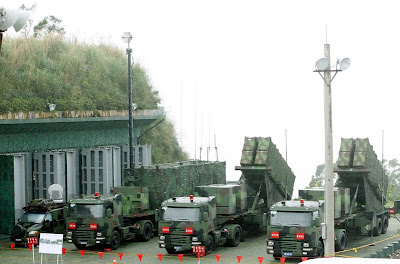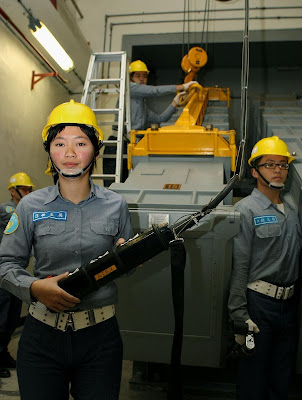Lankan Ranger
ELITE MEMBER

- Joined
- Aug 9, 2009
- Messages
- 12,550
- Reaction score
- 0
Taiwan Navy opens missile base in eastern Taiwan
The nation's navy opened yesterday a military base with Hsiung Feng II anti-ship missiles in eastern Taiwan to the media for the first time.
Officers and their men gave a demonstration of operations concerning installing and hanging the missiles onto the right positions for launching as well as removing them from missile racks afterward.
The naval missile base, called Guhai (fortifying the sea in Chinese) military base, is nestled in a mountain region in eastern Hualien.
With a camouflage that disguises the military base as an area for ordinary building compounds, the roof tiles of the structures have the special effects of deflecting satellite searches by unfriendly forces or parties.
There are housing units for residents and commercial hotels for tourists near the base.
The structures housing the missiles and troops can be easily mistaken for villas at a tourist resort.
Some of the missile facilities are concealed and some others are mounted on heavy-duty trucks for high mobility.
Troops handling Hsiung Feng II anti-ship missiles have regularly taken part in large-scale military exercises, including live fire tests in war games.
But this is the first time the navy has let reporters make an onsite tour of the military facilities.
The Hsiung Feng II anti-ship missiles measure 4.8 meters in length and can hit targets more than 100 kilometers away.
Navy opens missile base in eastern Taiwan to media - The China Post
The nation's navy opened yesterday a military base with Hsiung Feng II anti-ship missiles in eastern Taiwan to the media for the first time.
Officers and their men gave a demonstration of operations concerning installing and hanging the missiles onto the right positions for launching as well as removing them from missile racks afterward.
The naval missile base, called Guhai (fortifying the sea in Chinese) military base, is nestled in a mountain region in eastern Hualien.
With a camouflage that disguises the military base as an area for ordinary building compounds, the roof tiles of the structures have the special effects of deflecting satellite searches by unfriendly forces or parties.
There are housing units for residents and commercial hotels for tourists near the base.
The structures housing the missiles and troops can be easily mistaken for villas at a tourist resort.
Some of the missile facilities are concealed and some others are mounted on heavy-duty trucks for high mobility.
Troops handling Hsiung Feng II anti-ship missiles have regularly taken part in large-scale military exercises, including live fire tests in war games.
But this is the first time the navy has let reporters make an onsite tour of the military facilities.
The Hsiung Feng II anti-ship missiles measure 4.8 meters in length and can hit targets more than 100 kilometers away.
Navy opens missile base in eastern Taiwan to media - The China Post






